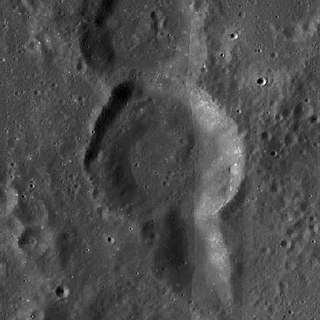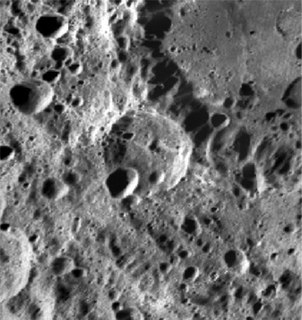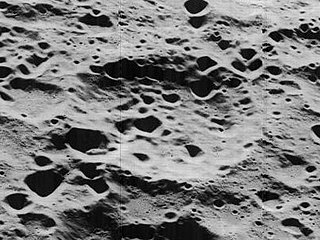
Albategnius is an ancient lunar impact crater located in the central highlands. It is named after the Muslim astronomer and scientist Muhammad ibn Jābir al-Harrānī al-Battānī, Latinized as Albategnius.

Müller is a lunar impact crater. It was named after Austrian astronomer Karl Müller. It is located in the highlands near the center of the Moon, in the center of the triangle formed by the much larger craters Albategnius, Ptolemaeus, and Hipparchus. To the east lies Halley, while to the northwest is Gyldén.

Klein is a lunar impact crater that is located across the western rim of the larger crater Albategnius, in the central highlands region of the Moon. The crater is named after German astronomer Hermann Joseph Klein.

Parrot is the remains of a lunar impact crater that has been almost completely worn away. It was named after Russian doctor and physicist Friedrich Parrot. It is attached to the southern rim of the crater Albategnius, and is located among the rugged highlands among the south-central part of the visible Moon. To the east is the small crater Vogel, and in the southeast is Arzachel.

Vogel is a small lunar impact crater located to the southeast of Albategnius. It was named after the German astronomer Hermann Carl Vogel. It is the smallest member of a trio of craters that increase in size from north to south, consisting of Vogel, Argelander and Airy. To the west is the remnant of the crater Parrot.

Burnham is a small crater located to the southeast of the crater Albategnius, in a relatively smooth area of the lunar surface. It was named after American astronomer Sherburne W. Burnham. To the southwest is Vogel.

Halley is a lunar impact crater that is intruding into the southern wall of the walled plain Hipparchus. Its diameter is 35 km. The crater is named after the English astronomer Edmond Halley. On the 1645 map by Michael van Langren, the crater is called Gansii, for the gansa of Francis Godwin's The Man in the Moone. To the southwest of Halley is the large crater Albategnius, and due east lies the slightly smaller Hind.

Cavendish is a lunar impact crater that is located in the southwest part of the Moon, to the southwest of the larger crater Mersenius. It lies between the smaller craters Henry to the west-northwest and de Gasparis to the east-southeast.

Franklin is a lunar impact crater that is located in the northeast part of the visible Moon; it is named after Benjamin Franklin. To the north-northwest is the smaller crater Cepheus, and in the opposite direction to the southwest is the shallow Berzelius.

Back is a small lunar impact crater that is located near the eastern limb of the Moon. It lies on the northwest edge of the Mare Smythii, and the northeast rim is adjacent to the crater Schubert. To the west is Jenkins, and to the southwest is the Weierstrass–Van Vleck crater pair.

Bohr is a lunar impact crater that is located near the western lunar limb, in the area that is affected by librations. It is attached to the southwestern rim of the larger, eroded Vasco da Gama formation, and to the southeast of the crater Einstein. The crater was observed for the first time in 1963, by Arthus and Ewen Whitaker in the book Rectified Lunar Atlas.

Belyaev is a lunar impact crater that is attached to the outer edge of the Mare Moscoviense, on the far side of the Moon. It is a worn formation with a small crater pair overlaying the southern rim, and several smaller craters across the relatively irregular interior.

Feuillée is a small lunar impact crater in the eastern part of the Mare Imbrium. It was named after French natural scientist Louis Feuillée. It lies less than a half crater diameter to the northwest of Beer, and the two formations form a nearly matched pair. To the west is the small but prominent crater Timocharis.

Cyrano is a lunar impact crater that lies on the far side of the Moon. It lies due east of the huge walled plain Gagarin, and to the north of the somewhat smaller crater Barbier.

Chaplygin is a large lunar impact crater that lies on the far side of the Moon. It is located to the southeast of the huge walled plain Mendeleev, about midway between the craters Schliemann to the northeast and Marconi to the southwest. It is about the same size as Albategnius on the near side.

Chang Heng is a lunar impact crater that is located on the Moon's far side. It lies less than one crater diameter to the northeast of the walled plain Fleming. The rim of this crater is somewhat eroded, with a pair of small craters along the northern rim and tiny craters along the south and east edges. The interior floor contains a small, concentric crater that is about one third the diameter of Chang Heng. The crater is named after Chinese astronomer Zhang Heng.

Dellinger is a lunar impact crater that is located on the Moon's far side. It is attached to the southern rim of the crater Pannekoek. To the southeast lies the crater Marconi, and to the southwest is Chauvenet.

Diderot is a small lunar impact crater on the far side of the Moon. It lies within the southwestern interior floor of the huge walled plain Fermi, about midway between the basin midpoint and the southwest rim. The crater is saucer-shaped, with smaller craters located just to the northwest and the north. The inner wall is narrower along the eastern side, and has a pair of ridges along the southern face. This crater is otherwise unremarkable.

Dunér is an old lunar impact crater that is located in the northern hemisphere on the far side of the Moon. It lies to the southeast of the crater Chernyshev, and west-southwest of the Perkin–Debye crater pair.

Elvey is a lunar impact crater that is located on the far side of the Moon. It is located near the northern edge of the blanket of ejecta that surrounds the Mare Orientale impact basin. To the north of Elvey is the smaller crater Nobel.





















